The Week in Space Pictures was something new we launched last week and we’re trying to improve on it with this eye-catching info graphic. Let us know what you think!

Space and astronomy news
The Week in Space Pictures was something new we launched last week and we’re trying to improve on it with this eye-catching info graphic. Let us know what you think!
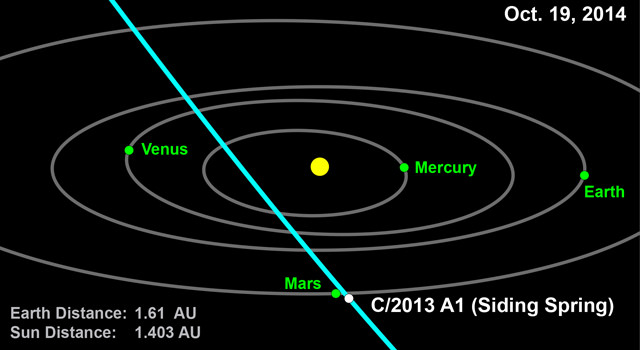
NASA’s Near-Earth Object Office says that new observations of comet C/2013 A1 (Siding Spring) have allowed further refinements of the comet’s orbit, helping to determine the chances it could hit Mars in October of 2014. Shortly after its discovery in December 2012, astronomers thought there was an outside chance that a newly discovered comet might be on a collision course with Mars.
While the latest orbital plot places the comet’s closest approach to Mars slightly closer than previous estimates, the new data now significantly reduces the probability the comet will impact the Red Planet, JPL said, from about 1 in 8,000 to about 1 in 120,000.
The closest approach is now estimated at about 68,000 miles (110,000 kilometers). The most previous estimates had it whizzing by at 186,000 miles (300,000 kilometers).
The latest estimated time for close approach to Mars is about 11:51 a.m. PDT (18:51 UTC) on Oct. 19, 2014. At the time of closest approach, the comet will be on the sunward side of the planet.
The comet was discovered in the beginning of 2013 by comet-hunter Robert McNaught at the Siding Spring Observatory in New South Wales, Australia. When the discovery was initially made, astronomers at the Catalina Sky Survey in Arizona looked back over their observations to find “prerecovery” images of the comet dating back to Dec. 8, 2012. These observations placed the orbital trajectory of comet C/2013 A1 right through Mars orbit on Oct. 19, 2014.
JPL says future observations of the comet are expected to refine the orbit further. The most up-to-date close-approach data can be found at JPL’s Small Body Database.
Source: JPL
An interesting news item from Iran’s Entkhab news agency: Iranian scientist Ali Razeghi – who is also the managing director of Iran’s Center for Strategic Inventions — has registered a new invention of his own making: a time machine.
It’s doesn’t actually take anyone to the past or future, but produces printed reports with details about the future, and can “predict five to eight years of the future life of any individual, with 98 percent accuracy” according to Razeghi, as quoted in The Telegraph.
“My invention easily fits into the size of a personal computer case and can predict details of the next 5-8 years of the life of its users,” he says. It will not take you into the future, it will bring the future to you.”
Razeghi, 27, says he has been working the project for 10 years and this is the 179th invention he has registered.
The “time machine” would be a good resource for governments, he said, but he doesn’t want to launch a prototype at this point because “the Chinese will steal the idea and produce it in millions overnight.”
Razeghi said his latest project has been criticized by friends for “trying to play God” with ordinary lives and history. “This project is not against our religious values at all,” Razaghi was quoted. “The Americans are trying to make this invention by spending millions of dollars on it where I have already achieved it by a fraction of the cost.”
Of course, this has spurred articles about Doc Brown and DeLoreans, with hardly anyone taking this seriously.

Here’s a view you don’t often see: Greenland’s glaciers from 500 meters above the ice. But this new video from NASA’s Operation IceBridge — recorded on April 9, 2013 — shows areas of southeast Greenland using a cockpit camera, revealing what the pilots see as they fly NASA’s P-3B airborne laboratory low over the Arctic. Following a glacier’s sometimes winding flow line gives IceBridge researchers a perspective on the ice not possible from satellites which pass in straight lines overhead. By gathering such data, IceBridge is helping to build a continuous record of change in the polar regions.
The plane allows researchers to images Earth’s polar ice in unprecedented detail to better understand processes that connect the polar regions with the global climate system. IceBridge utilizes a highly specialized fleet of research aircraft and the most sophisticated suite of innovative science instruments ever assembled to characterize annual changes in thickness of sea ice, glaciers, and ice sheets. In addition, IceBridge collects critical data used to predict the response of earth’s polar ice to climate change and resulting sea-level rise. IceBridge also helps bridge the gap in polar observations between NASA’s ICESat satellite missions.
Find out more about Operation IceBrige at their website.
Yuri’s Night commemorates two space milestones in history that both occurred on April 12: in 1961, cosmonaut Yuri Gagarin made the first human spaceflight, and in 1981, the inaugural launch of NASA’s Space Shuttle. Yuri’s Night is a global celebration of humanity’s past, present, and future in space. Yuri’s Night parties and events are held around the world, and you can check the Yuri’s Night website to see if there is an event near you.
The astronauts and cosmonauts on the ISS will celebrate (see video below), and the first ever Yuri’s Night on another world is being held via Twitter and Facebook along with the Curiosity rover.
Yuri’s Night events combine space-themed partying with education and outreach. These events can range from an all-night mix of techno and technology at a NASA Center, to a movie showing and stargazing at your local college, to a gathering of friends at a bar or barbecue.
In 2011, the 50th anniversary of human spaceflight, over 100,000 people attended 567 officially-recognized events in 75 countries on all 7 continents, while tens of thousands more watched the 12-hour live Yuri’s Night Global Webcast and participated online in the virtual world of Second Life.
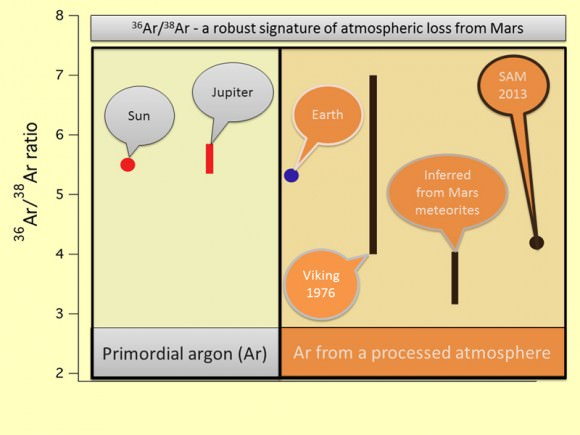
In this latest video update from the Mars Science Laboratory team, Ashwin Vasavada, the mission’s Deputy Project Scientist, discusses the recent finding that the Red Planet doesn’t have the same atmosphere it used to. Curiosity’s microwave oven-sized Sample Analysis at Mars (SAM) instrument analyzed an atmosphere sample and the results provided the most precise measurements ever made of isotopes of argon in the Martian atmosphere.
Given the popularity of the recent contest by Uwingu to suggest names for the closest known exoplanet to Earth (officially named Alpha Centauri Bb or ACBb for short), the International Astronomical Union has issued a statement about their stance on the “official” naming process. The IAU says that while they welcome the public’s interest in being involved in recent discoveries, as far as they are concerned, the IAU has the last word.
“In the light of recent events, where the possibility of buying the rights to name exoplanets has been advertised, the International Astronomical Union (IAU) wishes to inform the public that such schemes have no bearing on the official naming process. The IAU… would like to strongly stress the importance of having a unified naming procedure,” said the statement issued by the IAU.
Scientist Alan Stern, principal investigator of the New Horizons mission to Pluto and CEO Uwingu told Universe Today that he thinks the IAU should side with democracy instead of elitism.
“I think it is diminishing that the IAU is holding onto their claim that they own the Universe,” he said via phone after reviewing the IAU’s statement. “This is like some 15th century European academic club claiming that since Columbus discovered America, they own all the naming rights. That’s BS.”
While the IAU provides official names for stars and planetary bodies in our Solar System, the IAU’s official stance on naming exoplanets has been that since there is seemingly going to be so many of them, (over 800 have been discovered so far) that it will be difficult to name them all. They’ve said the consensus among IAU scientists was that they had no interest in naming exoplanets.
However, they recently added a few sentences on their website that “the IAU greatly appreciates and wishes to acknowledge the increasing interest from the general public in being more closely involved in the discovery and understanding of our Universe. As a result in 2013 the IAU Commission 53 Extrasolar Planets and other IAU members will be consulted on the topic of having popular names for exoplanets, and the results will be made public on the IAU website.”
Stern thinks the IAU’s current stance on naming exoplanets is tactical mistake. “The taxpaying public pays for all the exploration that the IAU members are doing, but the IAU is making an attempt to limit the public’s involvement in something that the public clearly likes to do,” he said. “As an astronomer, that’s my view.”
Uwingu, a startup company that is using out-of-the-box ideas to raise funds for space exploration and science, started an exoplanet naming contest last fall, and the contest to provide a better, “snappier” name for ACBb was started in March, 2013.
Stern knew going into this that the names wouldn’t officially be approved by the International Astronomical Union, but said they will be similar to the names given to features on Mars by the mission science teams (such as Mt. Sharp on Mars –the IAU-approved name is Aeolis Mons) or even like Pike’s Peak, a mountain in Colorado which was named by the public, in a way, as early settlers started calling it that, and it soon became the only name people recognized.
“This should be the wave of the future for planets and there’s no reason for the public not to get involved,” Stern said.
In today’s statement, the IAU said the “certificates” people receive after suggesting a name in Uwingu’s contest are “misleading, as these campaigns have no bearing on the official naming process — they will not lead to an officially-recognized exoplanet name, despite the price paid or the number of votes accrued.”
The IAU conceded that while exoplanet names such as 16 Cygni Bb or HD 41004 Ab may seem boring compared to the names of planets in our own Solar System, “the vast number of objects in our Universe — galaxies, stars, and planets to name just a few — means that a clear and systematic system for naming these objects is vital. Any naming system is a scientific issue that must also work across different languages and cultures in order to support collaborative worldwide research and avoid confusion.”
And to make that possible, the IAU should act as a single arbiter of the naming process, they said.
“As an international scientific organization, [the IAU] dissociates itself entirely from the commercial practice of selling names of planets, stars or or even “real estate” on other planets or moons. These practices will not be recognized by the IAU and their alternative naming schemes cannot be adopted.”
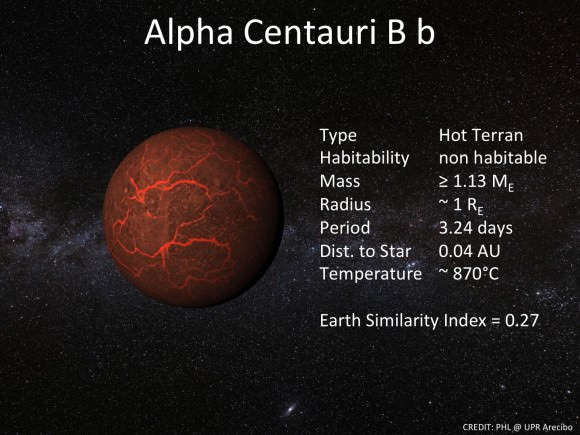
However, several astronomers, including Xavier Dumusque, the lead author of the paper that announced the discovery of ACBb has said they like the idea of having the public involved in naming the exoplanets.
“I would definitively endorse the name for public outreach and lectures,” Dumusque told Alan Boyle of NBC’s Cosmic Log. “In astronomy, we have some chance to be able to make people dream, by showing a wonderful picture, by discovering new worlds. If someone is interested in astronomy, he should not face troubles to understand all the nomenclature. Therefore, giving memorable names for planets is one way to get more people interested in our wonderful research.”
Moonwalker Buzz Aldrin also has been actively participating in the contest and suggested “Tiber” as the name for ACBb. Aldrin is the co-author of a 1977 sci-fi novel titled “Encounter With Tiber.”
IAU’s reticence in naming exoplanets seems to come from the huge bulk of names that will be required. But that’s where Uwingu’s crowd sourcing idea seems to fit the need, and a sort of compromise would be that the public could come up with the names as suggestions in Uwingu’s “baby book” of names, and the IAU would assign the “official” names from the list provided by the public.
If nothing else, Uwingu’s concept has shown how interested the public is in exoplanets and hopefully has given the IAU the kick in the pants needed to possibly consider naming them.
If you’re interested in suggesting names for ACBb, be quick, as the Uwingu contest ends on April 15.

With its 180 degree views of Earth and space, the ISS’s cupola is the perfect place for photography. But Austrian researchers want to use the unique and panoramic platform to test the limits of “spooky action at distance” in hopes of creating a new quantum communications network.
In a new study published April 9, 2012 in the New Journal of Physics, a group of Austrian researchers propose equipping the camera that is already aboard the ISS — the Nikon 400 mm NightPOD camera — with an optical receiver that would be key to performing the first-ever quantum optics experiment in space. The NightPOD camera faces the ground in the cupola and can track ground targets for up to 70 seconds allowing researchers to bounce a secret encryption key across longer distances than currently possible with optical fiber networks on Earth.
“During a few months a year, the ISS passes five to six times in a row in the correct orientation for us to do our experiments. We envision setting up the experiment for a whole week and therefore having more than enough links to the ISS available,” said co-author of the study Professor Rupert Ursin from the Austrian Academy of Sciences.
Albert Einstein first coined the phrase ‘spooky action at a distance’ during his philosophical battles with Neils Bohr in the 1930s to explain his frustration with the inadequacies of the new theory called quantum mechanics. Quantum mechanics explains actions on the tiniest scales in the domain of atoms and elemental particles. While classical physics explains motion, matter and energy on the level that we can see, 19th century scientists observed phenomena in both the macro and micro world that could not easily explained using classical physics.
In particular, Einstein was dissatisfied with the idea of entanglement. Entanglement occurs when two particles are so deeply connected that they share the same existence; meaning that they share the same mathematical relationships of position, spin, momentum and polarization. This could happen when two particles are created at the same point and instant in spacetime. Over time, as the two particles become widely separated in space, even by light-years, quantum mechanics suggests that a measurement of one would immediately impact the other. Einstein was quick to point out that this violated the universal speed limit set out by special relativity. It was this paradox Einstein referred to as spooky action.
CERN physicist John Bell partially resolved this mystery in 1964 by coming up with the idea of non-local phenomena. While entanglement allows one particle to be instantaneously influenced by its exact counterpart, the flow of classical information does not travel faster than light.
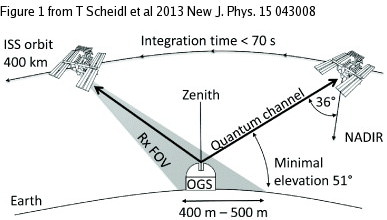
“According to quantum physics, entanglement is independent of distance. Our proposed Bell-type experiment will show that particles are entangled, over large distances — around 500 km — for the very first time in an experiment,” says Ursin. “Our experiments will also enable us to test potential effects gravity may have on quantum entanglement.”
The researchers point out that making the minor alteration to a camera already aboard the ISS will save time and money needed to build a series of satellites to test researchers’ ideas.
If that title seems like an obvious statement to you, it’s ok… it seems pretty obvious to me too. But there are those who have been suggesting — for quite some time, actually — that earthquakes can be triggered or strengthened by solar activity; that, in fact, exceptionally powerful solar flares, coronal mass ejections, and other outpourings from our home star can cause the planet’s crust to shift, shake, and shudder.
Except that that’s simply not true — at least, not according to a recent study by researchers from the USGS.
Researchers Dr. Jeffrey Love from the United States Geological Survey and Dr. Jeremy Thomas from Northwest Research Associates compared historical data of solar activity with earthquake occurrences around the world and found no definitive correlations… nothing to suggest that one directly influenced the other.
“Recently there’s been a lot of interest in this subject from the popular press, probably because of a couple of larger and very devastating earthquakes. This motivated us to investigate for ourselves whether or not it was true.”
– Jeffrey Love, USGS Research Geophysicist
Even when an earthquake may have been found to occur on the same day as increased solar activity, at other times during even stronger quakes the Sun may have been relatively quiet, and vice versa.

“There have been some earthquakes like the 9.5 magnitude Chile quake in 1960 where, sure enough, there were more sunspots and more geomagnetic activity than on average,” said Dr. Love. “But then for the Alaska earthquake in 1964 everything was lower than normal. There’s no obvious pattern between solar activity and seismicity, so our results were inconclusive.”
Basically, even though our planet orbits within the Sun’s outer atmosphere and we are subject to the space weather it creates — and there’s still a lot to be learned about that — observations do not indicate any connection between sunspots, flares, and CMEs and the shifting of our planet’s crust (regardless of what some may like to suggest.)
“It’s natural for scientists to want to see relationships between things,” said Love. “Of course, that doesn’t mean that a relationship actually exists!”
The team’s findings were published in the March 16, 2013 online edition of Geophysical Research Letters.
Read more in Harriet Jarlett’s article on Planet Earth Online, and for results from another study see Dr. Ryan O’Milligan’s article on TheSunToday.org.
(Oh, and the Moon doesn’t cause earthquakes either.)
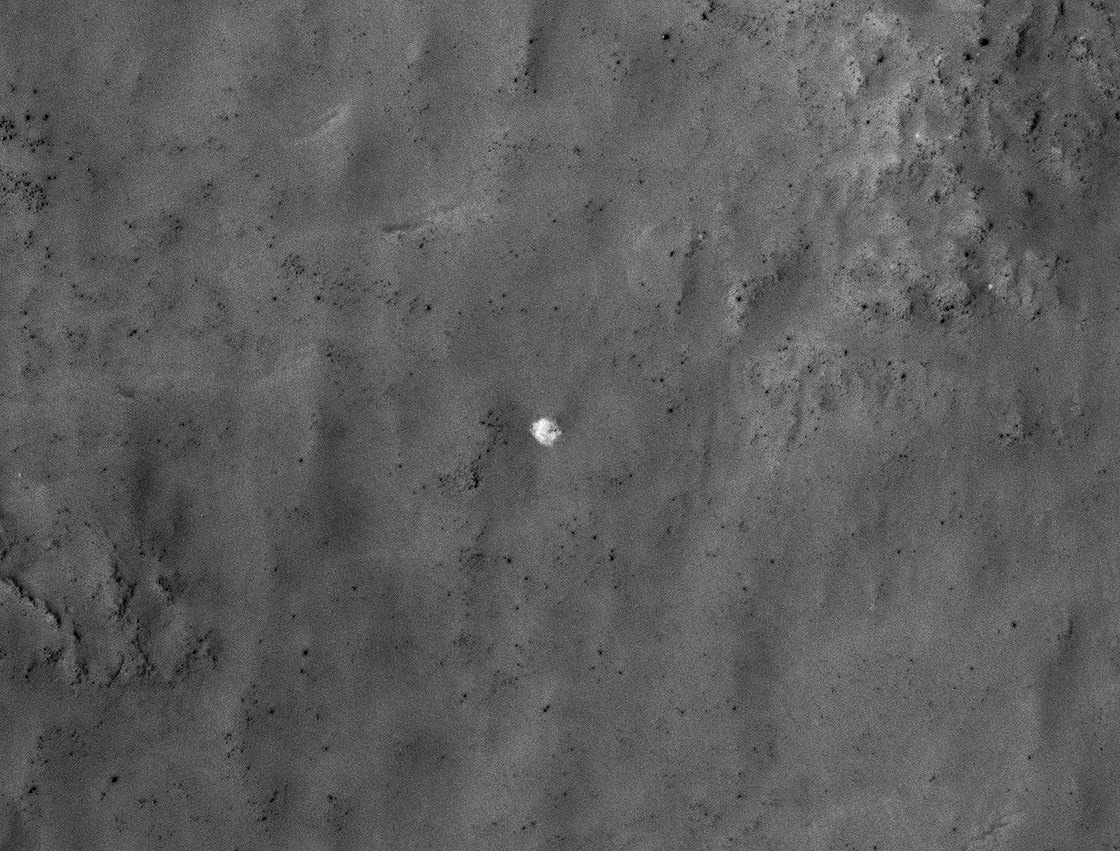
On May 28, 1971, the Soviet Union launched the Mars 3 mission which, like its previously-launched and ill-fated sibling Mars 2, consisted of an orbiter and lander destined for the Red Planet. Just over six months later on December 2, 1971, Mars 3 arrived at Mars — five days after Mars 2 crashed. The Mars 3 descent module separated from the orbiter and several hours later entered the Martian atmosphere, descending to the surface via a series of parachutes and retrorockets. (Sound familiar?) Once safely on the surface, the Mars 3 lander opened its four petal-shaped covers to release the 4.5-kg PROP-M rover contained inside… and after 20 seconds of transmission, fell silent. Due to unknown causes, the Mars 3 lander was never heard from or seen again.
Until now.
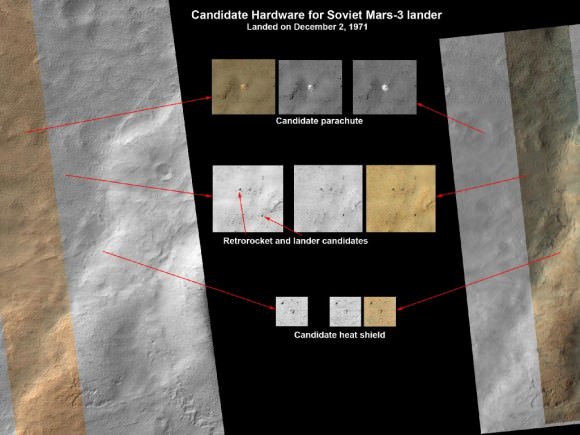
The set of images above shows what might be hardware from the 1971 Soviet Mars 3 lander, seen in a pair of images from the High Resolution Imaging Science Experiment (HiRISE) camera on NASA’s Mars Reconnaissance Orbiter.
While following news about Mars and NASA’s Curiosity rover, Russian citizen enthusiasts found four features in a five-year-old image from Mars Reconnaissance Orbiter that resemble four pieces of hardware from the Mars 3 mission: the parachute, heat shield, terminal retrorocket and lander. A follow-up image by the orbiter from last month shows the same features.
“Together, this set of features and their layout on the ground provide a remarkable match to what is expected from the Mars 3 landing, but alternative explanations for the features cannot be ruled out.”
– Alfred McEwen, HiRISE Principal Investigator
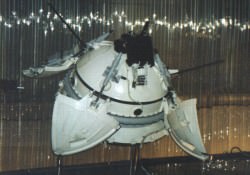
Vitali Egorov from St. Petersburg, Russia, heads the largest Russian Internet community about Curiosity. His subscribers did the preliminary search for Mars 3 via crowdsourcing. Egorov modeled what Mars 3 hardware pieces should look like in a HiRISE image, and the group carefully searched the many small features in this large image, finding what appear to be viable candidates in the southern part of the scene. Each candidate has a size and shape consistent with the expected hardware, and they are arranged on the surface as expected from the entry, descent and landing sequence.
“I wanted to attract people’s attention to the fact that Mars exploration today is available to practically anyone,” Egorov said. “At the same time we were able to connect with the history of our country, which we were reminded of after many years through the images from the Mars Reconnaissance Orbiter.”
The predicted Mars 3 landing site was at latitude 45 degrees south, longitude 202 degrees east, in Ptolemaeus Crater. HiRISE acquired a large image at this location in November 2007, and promising candidates for the hardware from Mars 3 were found on Dec. 31, 2012.
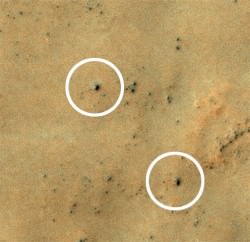
The candidate parachute is the most distinctive feature in the images (seen above at top.) It is an especially bright spot for this region, about 8.2 yards (7.5 meters) in diameter.
The parachute would have a diameter of 12 yards (11 meters) if fully spread out over the surface, so this is consistent.
“Together, this set of features and their layout on the ground provide a remarkable match to what is expected from the Mars 3 landing, but alternative explanations for the features cannot be ruled out,” said HiRISE Principal Investigator Alfred McEwen of the University of Arizona, Tucson. “Further analysis of the data and future images to better understand the three-dimensional shapes may help to confirm this interpretation.”
Source: NASA/JPL